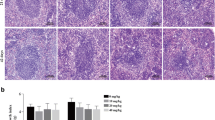Abstract
Increasing evidences show that bisphenol A(BPA) affects immune responses, which the mechanism is mainly regarded as estrogenic effect on a variety of immune cells. Besides its estrogenic activity, BPA can cause oxidative damage of liver, kidneys and brain. Due to limited information concerning the effect of BPA on spleen, a principle site for initiation of primary immune responses, especially no data are available on its actions on the mitochondrial functions of spleen. To assess this effect, C57BL/6 female mice were exposed to BPA by drinking water at doses of 1 or 10 μg/mL for 4 weeks. The mitochondrial membrane potential (δϕ), cellular ATP levels and the parameters of oxidative stress were measured in spleen cells. Measures of oxidative stress were also performed on the liver and kidneys of these hosts. The results showed a statistically significant induction of mitochondrial dysfunction, including decreased δϕ and ATP levels. Decreased activities of superoxide dismutase (SOD) and total anti-oxidative capacity (T-AOC), and increased malondialdehye (MDA) levels were also found in spleens of BPA-exposed mice. These parameters of oxidative stress were also noted in the kidneys, but only at the highest dose of BPA tested; liver parameters remained unaffected regardless of BPA dose. Data from this study demonstrate that BPA led to mitochondrial dysfunction in splenocytes and that this dysfunction was seemingly associated with an increase in local oxidative stress.
Similar content being viewed by others
References
Chapin, R. E. et al. NTP-CERHR expert panel report on the reproductive and developmental toxicity of bisphenol A. Dev Reprod Toxicol 83:157–395 (2008).
Ben-Jonathan, N., Hugo, E. R. & Brandebourg, T. D. Effects of bisphenol A on adipokine release from human adipose tissue: Implications for the metabolic syndrome. Mol Cell Endocrinol 304:49–54 (2009).
Groff, T. Bisphenol A: Invisible pollution. Curr Opin Pediat 22:524–529 (2010).
Rogers, J. A., Metz, L. & Yong, V. W. Endocrine disrupting chemicals and immune responses: A focus on bisphenol-A and potential mechanisms. Mol Immunol 53:421–430 (2013).
Goto, M., Ono, H., Takano-Ishikawa, Y., Shinmoto, H. & Yoshida, M. Mac1+ cells are required for enhancement of splenocytes proliferation caused by bisphenol A. Biosci Bio-technol Biochem 68:263–265 (2004).
Yan, H., Takamoto, M. & Sugane, K. Exposure to bisphenol A prenatally or in adulthood promotes TH2 cytokine production associated with reduction of CD4+ CD25+ regulatory T-cells. Environ Health Perspect 116:514–519 (2008).
Donohue, K. M. et al. Prenatal postnatal bisphenol A exposure and asthma development among inner-city children. J Allergy Clin Immunol 131:736–742 (2013).
Kuan, Y. H., Huang, F. M., Li, Y. C. & Chang, Y. C. Pro-inflammatory activation of macrophages by bisphenol A-glycidyl-methacrylate involved NF-κB activation via PI3K/Akt pathway. Food Chem Toxicol 50: 4003–4009 (2012).
Hassan, Z. K. et al. Bisphenol A induces hepatotoxicity through oxidative stress in rat model. Oxid Med Cell Longev doi: 10.1155/2012/194829 (2012).
Moon, M. K. et al. Bisphenol A impairs mitochondrial function in the liver at doses below the no-observed-adverse-effect level. J Korean Med Sci 27:644–652 (2012).
Picard, M. & Turnbull, D. M. Linking the metabolic state and mitochondrial DNA in chronic disease, health, and aging. Diabetes 62:672–678 (2013).
Lin, Y. et al. Exposure to bisphenol A induces dysfunction of insulin secretion and apoptosis through the damage of mitochondria in rat insulinoma (INS-1) cells. Cell Death Dis 4:e460 (2013).
Miao, S. et al. Influence of bisphenol A on devel-oping rat estrogen receptors and some cytokines in rats: A two-generational study. J Toxicol Environ Health 71: 1000–1008 (2008).
Rubtsov, A. V., Rubtsova, K., Kappler, J. W. & Marrack, P. Genetic and hormonal factors in female-biased autoimmunity. Autoimmun Rev 9:494–498 (2010).
Yurino, H. et al. Endocrine disruptors (environmental estrogens) enhance autoantibody production by B1 cells. Toxicol Sci 81:139–147 (2004).
Guo, H. et al. Bisphenol A in combination with TNFα selectively induces TH2 cell-promoting dendritic cells in vitro with an estrogen-like activity. Cell Mol Immunol 7:227–234 (2010).
Bonefeld-Jorgensen, E. C., Long, M., Hofmeister, M. V. & Vinggaard, A. M. Endocrine-disrupting potential of bisphenol A, bisphenol A dimethacrylate, 4-n-nonylphenol, and 4-n-octylphenol in vitro: New data and a brief review. Environ Health Perspect 115:69–76 (2007).
Frericks, M., Meissner, M. & Esser, C. Microarray analysis of the AhR system: Tissue-specific flexibility in signal and target genes. Toxicol Appl Pharmacol 220:320–332 (2007).
Midoro-Horiuti, T., Tiwari, R., Watson, C. S. & Goldblum, R. M. Maternal bisphenol A exposure promotes the development of experimental asthma in mouse pups. Environ Health Perspect 118:273–277 (2010).
Selgrade, M. K., Blain, R. B., Fedak, K. M. & Cawley, M. A. Potential risk of asthma associated with in utero exposure to xenobiotics. Birth Defects Res. C Embryo Today 99:1–13 (2013).
Chepelev, N. L. et al. Bisphenol A activates the Nrf1/2-anti-oxidant response element pathway in HEK 293 cells. Chem Res Toxicol 26:498–506 (2013).
Vandenberg, L. N. et al. Urinary, circulating, and tissue biomonitoring studies indicate wide-spread exposure to bisphenol A. Environ Health Perspect 118: 1055–1070 (2010).
Magliano, D. J. & Lyons, J. G. Bisphenol A and diabetes, insulin resistance, cardiovascular disease and obesity: Controversy in a (plastic) cup? J Clin Endocrinol Metab 98:502–504 (2013).
Akingbemi, B. T., Sottas, C. M., Koulova, A. I., Klinefelter, G. R. & Hardy, M. P. Inhibition of testicular steroidogenesis by the xenoestrogen bisphenol A is associated with reduced pituitary luteinizing hormone secretion and decreased steroidogenic enzyme gene expression in rat Leydig cells. Endocrinology 145:592–603 (2004).
Yildiz, N. & Barlas, N. Hepatic and renal functions in growing male rats after bisphenol A and octylphenol exposure. Human Exp Toxicol 32:675–786 (2013).
Tyl, R. W. et al. Two-generation reproductive toxicity study of dietary bisphenol A in CD-1 (Swiss) mice. Toxicol Sci 104:362–384 (2008).
Somm, E. et al. Perinatal exposure to bisphenol A alters early adipogenesis in the rat. Environ Health Perspect 117:1549–1555 (2009).
Author information
Authors and Affiliations
Corresponding author
Rights and permissions
About this article
Cite this article
Dong, Y., Zhai, L., Zhang, L. et al. Bisphenol A impairs mitochondrial function in spleens of mice via oxidative stress. Mol. Cell. Toxicol. 9, 401–406 (2013). https://doi.org/10.1007/s13273-013-0049-5
Received:
Accepted:
Published:
Issue Date:
DOI: https://doi.org/10.1007/s13273-013-0049-5




